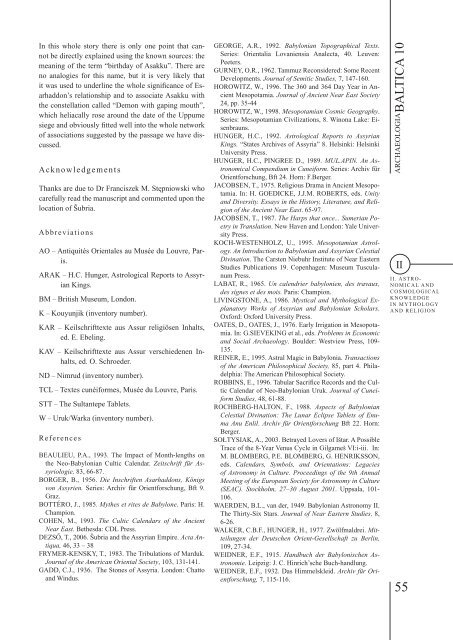BALTICA10
BALTICA10
BALTICA10
Create successful ePaper yourself
Turn your PDF publications into a flip-book with our unique Google optimized e-Paper software.
In this whole story there is only one point that cannot<br />
be directly explained using the known sources: the<br />
meaning of the term “birthday of Asakku”. There are<br />
no analogies for this name, but it is very likely that<br />
it was used to underline the whole significance of Esarhaddon’s<br />
relationship and to associate Asakku with<br />
the constellation called “Demon with gaping mouth”,<br />
which heliacally rose around the date of the Uppume<br />
siege and obviously fitted well into the whole network<br />
of associations suggested by the passage we have discussed.<br />
Acknowledgements<br />
Thanks are due to Dr Franciszek M. Stępniowski who<br />
carefully read the manuscript and commented upon the<br />
location of Šubria.<br />
Abbreviations<br />
AO – Antiquités Orientales au Musée du Louvre, Paris.<br />
ARAK – H.C. Hunger, Astrological Reports to Assyrian<br />
Kings.<br />
BM – British Museum, London.<br />
K – Kouyunjik (inventory number).<br />
KAR – Keilschrifttexte aus Assur religiösen Inhalts,<br />
ed. E. Ebeling.<br />
KAV – Keilschrifttexte aus Assur verschiedenen Inhalts,<br />
ed. O. Schroeder.<br />
ND – Nimrud (inventory number).<br />
TCL – Textes cunéiformes, Musée du Louvre, Paris.<br />
STT – The Sultantepe Tablets.<br />
W – Uruk/Warka (inventory number).<br />
References<br />
BEAULIEU, P.A., 1993. The Impact of Month-lengths on<br />
the Neo-Babylonian Cultic Calendar. Zeitschrift für Assyriologie,<br />
83, 66-87.<br />
BORGER, B., 1956. Die Inschriften Asarhaddons, Königs<br />
von Assyrien. Series: Archiv für Orientforschung, Bft 9.<br />
Graz.<br />
BOTTÉRO, J., 1985. Mythes et rites de Babylone. Paris: H.<br />
Champion.<br />
COHEN, M., 1993. The Cultic Calendars of the Ancient<br />
Near East. Bethesda: CDL Press.<br />
DEZSŐ, T., 2006. Šubria and the Assyrian Empire. Acta Antiqua,<br />
46, 33 – 38<br />
FRYMER-KENSKY, T., 1983. The Tribulations of Marduk.<br />
Journal of the American Oriental Society, 103, 131-141.<br />
GADD, C.J., 1936. The Stones of Assyria. London: Chatto<br />
and Windus.<br />
GEORGE, A.R., 1992. Babylonian Topographical Texts.<br />
Series: Orientalia Lovaniensia Analecta, 40. Leuven:<br />
Peeters.<br />
GURNEY, O.R., 1962. Tammuz Reconsidered: Some Recent<br />
Developments. Journal of Semitic Studies, 7, 147-160.<br />
HOROWITZ, W., 1996. The 360 and 364 Day Year in Ancient<br />
Mesopotamia. Journal of Ancient Near East Society<br />
24, pp. 35-44<br />
HOROWITZ, W., 1998. Mesopotamian Cosmic Geography.<br />
Series: Mesopotamian Civilizations, 8. Winona Lake: Eisenbrauns.<br />
HUNGER, H.C., 1992. Astrological Reports to Assyrian<br />
Kings. “States Archives of Assyria” 8. Helsinki: Helsinki<br />
University Press.<br />
HUNGER, H.C., PINGREE D., 1989. MUL.APIN. An Astronomical<br />
Compendium in Cuneiform. Series: Archiv für<br />
Orientforschung, Bft 24. Horn: F.Berger.<br />
JACOBSEN, T., 1975. Religious Drama in Ancient Mesopotamia.<br />
In: H. Goedicke, J.J.M. Roberts, eds. Unity<br />
and Diversity. Essays in the History, Literature, and Religion<br />
of the Ancient Near East. 65-97.<br />
JACOBSEN, T., 1987. The Harps that once... Sumerian Poetry<br />
in Translation. New Haven and London: Yale University<br />
Press.<br />
KOCH-WESTENHOLZ, U., 1995. Mesopotamian Astrology.<br />
An Introduction to Babylonian and Assyrian Celestial<br />
Divination. The Carsten Niebuhr Institute of Near Eastern<br />
Studies Publications 19. Copenhagen: Museum Tusculanum<br />
Press.<br />
LABAT, R., 1965. Un calendrier babylonien, des travaux,<br />
des signes et des mois. Paris: Champion.<br />
LIVINGSTONE, A., 1986. Mystical and Mythological Explanatory<br />
Works of Assyrian and Babylonian Scholars.<br />
Oxford: Oxford University Press.<br />
OATES, D., OATES, J., 1976. Early Irrigation in Mesopotamia.<br />
In: G.SIEVEKING et al., eds. Problems in Economic<br />
and Social Archaeology. Boulder: Westview Press, 109-<br />
135.<br />
REINER, E., 1995. Astral Magic in Babylonia. Transactions<br />
of the American Philosophical Society, 85, part 4. Philadelphia:<br />
The American Philosophical Society.<br />
ROBBINS, E., 1996. Tabular Sacrifice Records and the Cultic<br />
Calendar of Neo-Babylonian Uruk. Journal of Cuneiform<br />
Studies, 48, 61-88.<br />
ROCHBERG-HALTON, F., 1988. Aspects of Babylonian<br />
Celestial Divination: The Lunar Eclipse Tablets of Enuma<br />
Anu Enlil. Archiv für Orientforschung Bft 22. Horn:<br />
Berger.<br />
SOŁTYSIAK, A., 2003. Betrayed Lovers of Ištar. A Possible<br />
Trace of the 8-Year Venus Cycle in Gilgameš VI:i-iii. In:<br />
M. BLOMBERG, P.E. BLOMBERG, G. HENRIKSSON,<br />
eds. Calendars, Symbols, and Orientations: Legacies<br />
of Astronomy in Culture. Proceedings of the 9th Annual<br />
Meeting of the European Society for Astronomy in Culture<br />
(SEAC). Stockholm, 27–30 August 2001. Uppsala, 101-<br />
106.<br />
WAERDEN, B.L., van der, 1949. Babylonian Astronomy II.<br />
The Thirty-Six Stars. Journal of Near Eastern Studies, 8,<br />
6-26.<br />
WALKER, C.B.F., HUNGER, H., 1977. Zwölfmaldrei. Mitteilungen<br />
der Deutschen Orient-Gesellschaft zu Berlin,<br />
109, 27-34.<br />
WEIDNER, E.F., 1915. Handbuch der Babylonischen Astronomie.<br />
Leipzig: J. C. Hinrich’sche Buch-handlung.<br />
WEIDNER, E.F., 1932. Das Himmelskleid. Archiv für Orientforschung,<br />
7, 115-116.<br />
ARCHAEOLOGIA BALTICA 10<br />
II<br />
II. ASTRO-<br />
NOMICAL AND<br />
COSMOLOGICAL<br />
KNOWLEDGE<br />
IN MYTHOLOGY<br />
AND RELIGION<br />
55
















